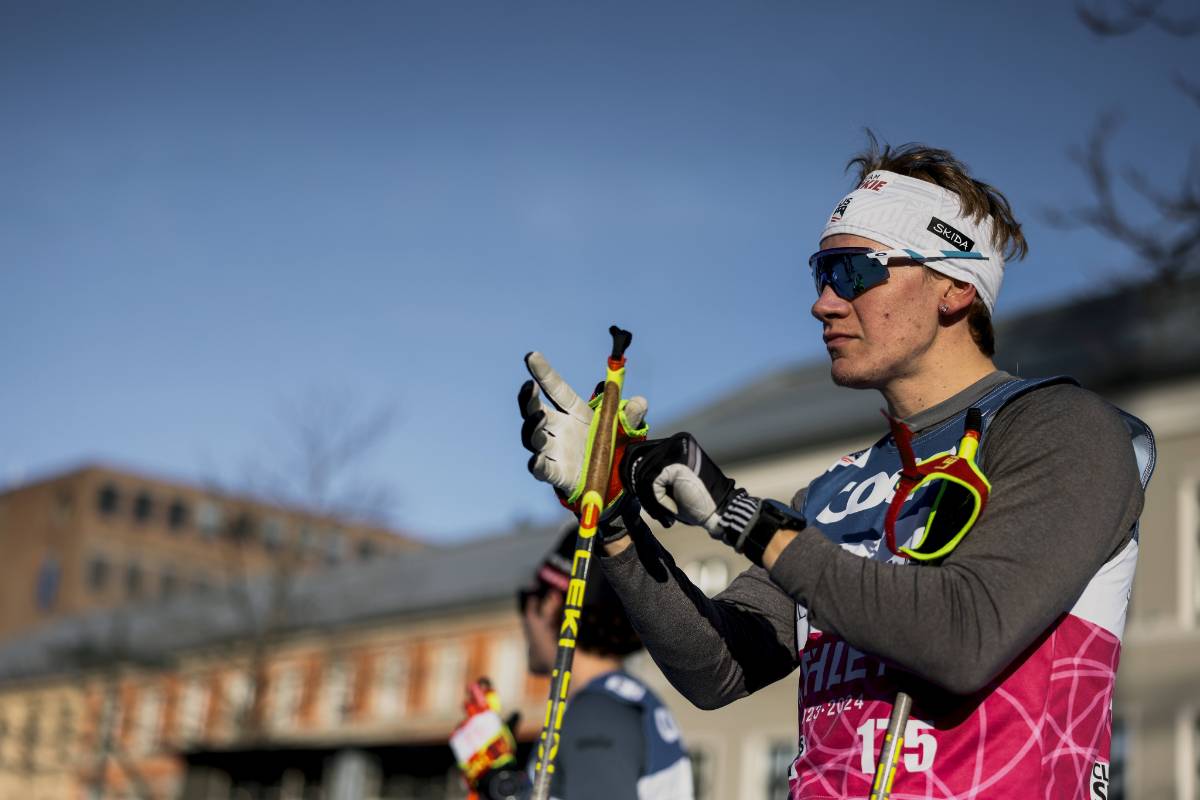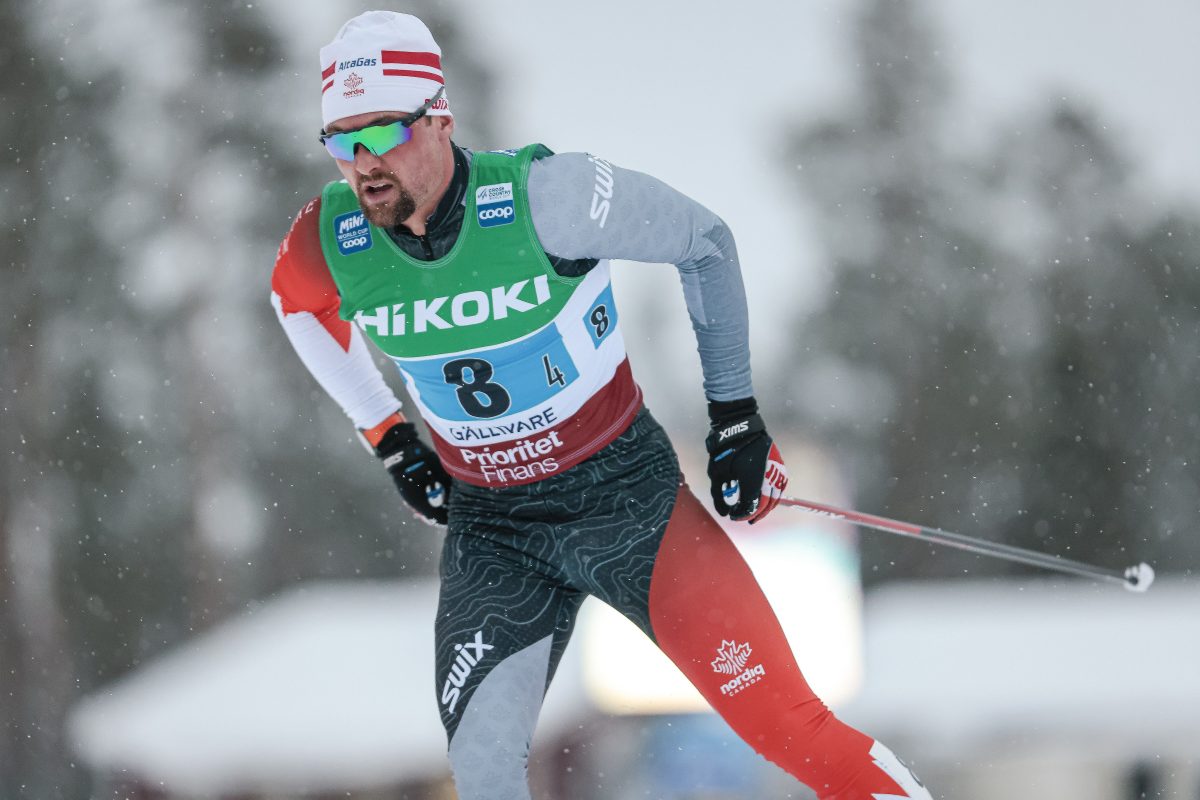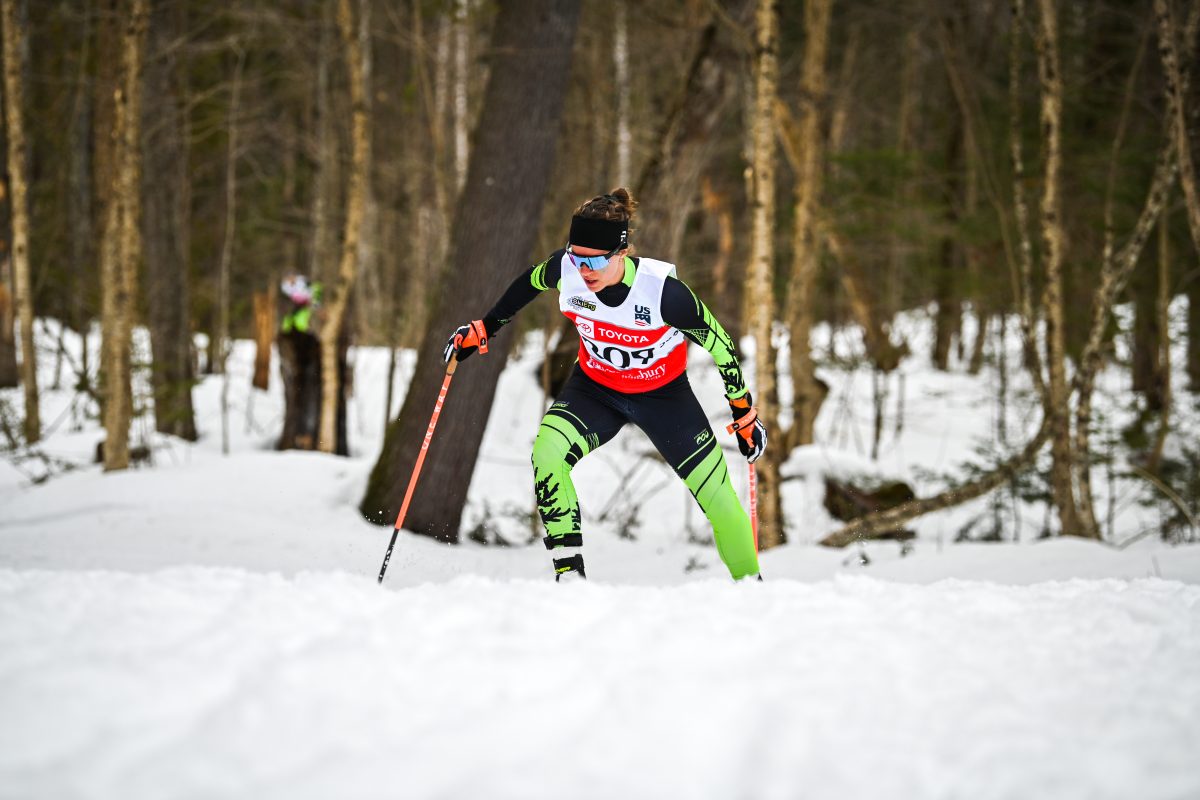Birch Hill and the Race Crew for the 2003 Junior Olympics were faced with their first major test of the season over the weekend of February 1st and 2nd, and both passed with flying colors. After warming up with the final two races in the Nordic Ski Club of Fairbanks’ Williams Alaska Petroleum Town Race Series, the final weekend of the Besh Cup, Alaska’s Junior Olympic Qualifying Series presented the organization and the venue with it’s biggest challenge to date.
The weatherman was on his best behavior. Warm temperatures — in the teens both days — made racing and spectating a great pleasure. The sun even shone brightly for much of Saturday’s event.
The Besh Cup finals had fields of approximately 250-275 entries each day, with 230-250 finishers. Entries came from all around the state. Several of the 42 positions within the Alaska quota to JO’s were riding on the outcome of the races. All the skiers who were on the bubble were putting their numbers on good and tight and preparing to put the hammer down.
Saturday UAF skiers were atop the ranking list. Sigrid Aas, a junior
from Norway, fresh off a 3rd-place finish in the Sprint at SRNC in
Rumford and three straight wins in the CCSA meets in the Midwest,
continued to strut her stuff with a convincing, 44-second victory in the
5km classic race over J1 Kassie Rice of the Alaska Winter Stars (AWS). Dartmouth grad Kate Pearson, who won a couple of Junior Olympic gold medals on her home-town courses at Birch Hill in the 1995 JO’s was third overall. Following Rice among juniors was Sally Johnson of Alaska Pacific University Nordic Ski Center (APUNSC) and East Anchorage HS (5th overall), and West Valley (Fairbanks) High School teammates and Nordic Ski Club of Fairbanks (NSCF) skiers Davya Baker (J1) and Adele Mery (1st J2, 4th junior). After Mery in the J2 class came Elizabeth Quinley of APU, Katelyn
Barnett of AWS, and Kelsey Coolidge of AWS.
Brett Broda of Lathrop HS and the host NSCF topped the boys’ J2 race on the same 5km course. Broda was 40 seconds faster than Daichi Ito of AWA/Service HS, and 1:04 ahead of Chugiak HS’ Nate Berry.
In the men’s 10km classic, Michal Malak of UAF, who had a top-10 finish in Rumford, and some podium finishes in the first couple of Central Collegiate Ski Association meets, topped APU’s James Southam by a mere 7 seconds, with UAF Assistant Coach Peter Barton another 8 seconds back. Former Olympians Todd Boonstra (1984-88-94), now teaching in Galena, Alaska , and Adam Verrier (1994) rounded out the top five. The top juniors were Colin Quinn-Hurst of APU, Justin Singleton of Eagle River Nordic Ski Club and Chugiak HS, Daniel Clark of East Anchorage HS, and Mike Hinckley of the Alaska Winter Stars and Service HS.
Saturday’s classic 5km course will be used at JO’s in the classic
individual event by the J2 Boys, and by the J2, J1, and OJ women. The course has 168m of climbing. The first 1/3 of the course is rolling. After an initial climb out of the start, there is a rolling downhill
stretch, followed by an undulating climb which brings the skiers back to the “upper stadium†before descending “the Ramp†to the main stadium and beginning the 43m climb to the top of the Tower Loop, the high point on the course. The Tower Direct climb is followed by over a kilometer of mostly downhill skiing which takes skiers out onto the White Bear loop. Just short of the Biathlon Stadium, the course bears left and follows a predominantly uphill route to the stadium, finishing with about 400m of flat and gradual skiing.
The 10km classic loop, which will be used by the J1 and OJ boys at JO’s, has 353m of climbing. After a short climb out of the stadium, the course descends for about 500m with some quick turns, before entering a series of steep climbs on the Competition loop. Competitors climb up the final face on the Competition loop to the upper stadium, bear left and return to a point within about 30m of the start, then head up the Ramp back to the upper stadium. From here the next 2.5-3km are the same as the women’s 5km loop.
At the Biathlon Stadium the men’s course continues east on the White Bear. Just beyond the range is a new, steep climb that gains about 20m. The course then rolls for about a kilometer before entering Moilanen’s Meadow, a 1.5km loop with a series of descents followed by moderately steep, but relatively short, climbs. After exiting Moilanen’s Meadow, the course rolls uphill for a short ways before descending back to the area of the Biathlon Stadium.
At that point the 10km rejoins the 5km course for the ascent to the
stadium. With about 200m to the finish of the 5km course, the 10km
course bears right and away from the finish line, descending the Warmup loop before beginning the final ascent, which ends at the finish line. The last 130m of the course are dead straight, 15m wide, and uphill at a 2.5% grade.
On Sunday, all J1-OJ-SR-MA skiers of both sexes skated 10km on the course that will be used by J1-OJ girls in the JO 10km skate. This is a very challenging course, with some very steep hills early in the course, including the climb out of the dreaded Black Hole. The high point on this course is 115m above the low point.
After ascending out of the start for the first 200m, the course descends to its low point (the Black Hole) over the next km, although the descent is interrupted periodically by short, relatively sharp climbs. After reaching the Black Hole, the course turns south and climbs very steeply, gaining over 50m. After reaching the top of the Black Hole climb, the course is flat for a bit before dropping down to the base of the Headwall climb, another steep climb which brings the skiers back onto the 5km loop. Another short, steep climb, followed by a gradual descent and the final climb up the last face of the Competition loop, and the skiers are back at the upper stadium and about 1/3 of the way into the race.
The middle 1/3 of the course is mostly rolling terrain with long gradual stretches, utilizing the Blue loop and the Relay loop, and passing back through the upper stadium and stadium before beginning the Tower Direct ascent (43m climb) to the course’s high point. A stretch of over 1km of steady, rolling downhill takes the skiers back down to the Biathlon Stadium, from which point they climb back up to the stadium, pass to the north of the new Birch Hill Cross Country Ski Center building, and ascend to the finish. If you watch this race from the upper stadium, you can see the skiers 7 times during the competition by walking about 50m. Great spectating!
The faces at the top of the rankings changed a bit from the previous
day. Kate Pearson, having been at home for another 24 hours, really cranked a super race. After being in a tight pack of 3-4 skiers one third of the way into the race, after the section with the most steep hills, Kate turned on the jets on the rolling section in the middle of
the race, and on the longer climbs in the final third of the race to
take the win by 43 seconds over Kelli Jo (Lindeman) Boonstra who had been in the thick of things early. APUNSC’s Erin Hamilton was third overall. Six seconds behind Hamilton in fourth overall, Davya Baker of NSCF/West Valley HS displaced Kassie Rice (AWS) atop the J1/OJ girls’ rankings by a three-second margin. Sally Johnson (APUNSC/East HS) and Diana Heimerl (UA Fairbanks) were 3rd and 4th among juniors.
In the men’s race, James Southam gained a little revenge from the
previous day’s outcome by winning the 10km in 26:02, more than half a minute ahead of Adam Verrier, and more than 40 seconds ahead of UAF’s Erik Wickstrom. Justin Singleton (ERNSC/Chugiak), Bart Dengel (Valdez NSC/Valdez HS) and Colin Quinn-Hurst were tops among the junior men, in 8th, 9th and 11th overall, respectively.
The J2’s competed over the same 5km skate course they will use at the JO’s. The 5km has 180m of climb. This course does not use the Black Hole loop, and it also leaves out the rolling section used in the middleof the 10km loop.
NSCF’s Brett Broda (Lathrop HS) and Adele Mery (West Valley HS) repeated their victories of Saturday. Broda again nudged Daichi Ito into 2nd place, this time by 15 seconds. Max Treinen (AWS/West Anchorage HS) and Nate Berry (Chugiak HS) were third and fourth. Mery and teammate and buddy Christina Gillis (NSCF/West Valley HS) captured the top two positions among J2 girl, ahead of Elizabeth Quinley (APUNSC/East HS) and Fiona Worcester.
Race Organization
Here are some notes on the JO race organization — an evaluation of how things went at the Besh Cup, and what to expect at Junior Olympics.
We are happy to announce that Peter
Graves, many-time voice of Olympic Cross Country Skiing, will be the
voice of the JO’s at Birch Hill. We are fortunate to have him.
As has been mentioned before, the live web-cam was feeding images of the
race to the Nordic Ski Club’s website (linkable from the JO website)
throughout the day.
The timing hardware and software, from Summit Systems (Ernie Page) of
Salt Lake City worked flawlessly. This system is so robust that even
when the operation of a vacuum cleaner in the timing building during the
race caused the system to re-boot, not a beat was skipped.
Results for each age class/sex/distance were printed immediately after the final finisher in that class/distance. Simultaneously, those
results were published to the web, during the race. John Schauer, our
network/web techie and Chief of Event Production, was walking around the stadium with his iPaq PDA, browsing the results over our wireless
network. Pretty slick.
Snow conditions were other than optimal, but our Chief of Course,
Russell Lizotte, and his assistants, Tom Helmers and Andy Blossy did a great job getting the courses ready. Despite the thin snow cover, the courses were in great shape. I heard no complaints from any competitors or coaches about the occasional light brown patches of snow. Maybe that’s because conditions around the state have been marginal all year, and everyone is accustomed to such. I am very confident that our Course Crew can do what is needed to ensure great conditions for JO’s.
Webmaster and IT Chief Skip Via recently uploaded the website which he created. I’m sure you’ll agree with me that <this website sets a new standard for JO web presence. Skip recently implemented a web survey form that parents can complete if they don’t want to utilize the hard-copy version. We will be adding content frequently in the next few weeks. Keep checking in and checking it out.
General Impressions:
As Chief of Competition, I could not have been happier with the weekend
of racing. The volunteers were plentiful, motivated and in high
spirits; the crew chiefs demonstrated that they are all thoroughly
familiar with their tasks, responsibilities, and priorities. They
understand clearly not just their own jobs, but how their jobs fit into
the big picture, and with whom they interact.
The only comparison I can draw to the JO race crew is the crew I was
lucky enough to be a part of at the 2002 Olympics in Soldier Hollow.
This outfit is GOOD!
The venue is a pleasure to work with. With much of our infrastructure
hard-wired, race day tasks are tremendously reduced and simplified. We have a few more touches to add, and a few refinements to make, but in general, I cannot imagine a better stadium, or one that is easier to prepare. The courses we used this weekend received very positive reviews from the competitors and coaches. Although the snow is thin, it is sufficient. An additional 3â€-4†would make a huge improvement, and if we were to receive 6â€-8†of new snow, we would be in heaven with absolutely no worries.
There is certainly much more to do in the next five weeks to prepare for JO’s — I don’t want to create the impression that we are ready at this moment to produce the kind of event we hope to produce in March. However, we have a clear idea of what needs to be accomplished between now and then, and we have the crew that can and will do it.
We have four weeks to prepare for the State HS Championships (February 27-28-March 1), which will be our final, big test — 200 skiers racing for three days in a row, with two individual races and a relay for each sex. I hope that for State HS Championships that we are in all but final condition, with only a few minor tweaks necessary in the eight days between the last day of the State Championships and the first day of Junior Olympic Competition.
I would like to thank all the volunteers, especially the great group of
crew chiefs that we have. In addition, I would like to thank what has
to be the best Organizing Committee ever assembled for a Junior
Olympics. Under the leadership of President Kent Karns, they have
raised the money we needed to enable us to achieve our goal of putting on “the best Junior Olympics ever.†The have also created great community support in many other ways.
I know that I speak for all the volunteers, the Competition Committee,
the Organizing Committee, the sponsors, and the Board and membership of the Nordic Ski Club of Fairbanks when I say that we are eager as eager can be to see the JO skiers and coaches arriving in Fairbanks. We really look forward to giving them the greatest Junior Olympic experience they could ever hope for.



